A digital piano is an electronic keyboard. It works as a conventional acoustic piano alternative in terms of sound and how it feels when playing. Designed to use either recorded samples or synthesized emulation of acoustic pianos, an internal loudspeaker is used for their amplification.
Digital pianos are also built with weighted keys to recreate an acoustic piano’s feel. They also come in the form of grand pianos and upright pianos.
Although digital pianos may lack the sound and feel of an acoustic piano, they’re more lightweight, smaller and cost less than acoustic pianos. What’s more, electronic keyboards don’t require tuning. The tunes can be altered to match that of a different instrument such as a pipe organ.
Electronic keyboards, just like other electronic musical instruments, connect to PA systems or amplifiers to produce loud sounds in places with large audiences. They can also produce low sounds to serve the use of headphones.
Other than pipe organs, digital pianos can emulate the sounds of the Hammond organ, electric pianos and harpsichord, among other instruments. An electronic piano can find use in music studios, music schools, theatres and churches to replace conventional music instruments.
As mentioned earlier, digital pianos are advanced modern versions of acoustic pianos. The more adapted pianos feature electronic speakers that play back top quality recordings upon pressing a key. The recorded sounds or samples were taken from acoustic pianos.
Designed for people of all ages and use in different fields, digital pianos are made for professional, personal or leisure use. The musical instruments, since their invention, have changed how hobbyists and musicians perform and even practice music.
They’ve redefined the music production and professionalism scene. Unlike acoustic pianos, digital pianos are more affordable and easier to learn and use for performance.
The instruments are versatile to give access to unlimited sounds and related effects. However, the precise number of sounds varies from one electronic keyboard to another. They also have storage space, memory and limitations on performance. Some models also allow for addition of sounds and memory.
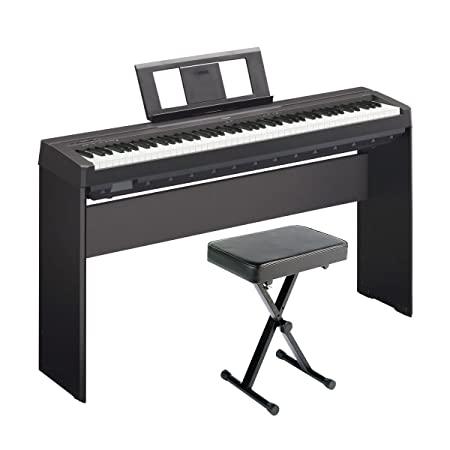
Differences between Digital Pianos and Keyboards
Some people use the terms “digital pianos” and “keyboards” interchangeably. However, the two refer to different musical instruments. The assumption that the two instruments are one and the same could lead to the purchase of a wrong product.
So, how does a digital piano differ from a keyboard?
The main difference between the two musical instruments is the purpose each is designed to accomplish. Traditional pianos are expensive, difficult to transport and come with many complex parts to support tuning. Getting them into an individual’s home is also inconvenient, costly and difficult.
Digital pianos are designed to deliver a similar experience to their acoustic pianos, without all the inconveniences mentioned above. They bridge the gap between a practice session in the bedroom or any other room at home, and the concert hall performance.
Electronic keyboards don’t just have the look, feel and capability of conventional pianos, but offer more in terms of digital effects, portability and connectivity to computers. This means the digital world offers more in terms of options, specifications and portability in digital pianos, but at lower costs.
On the other hand, keyboards mostly target beginner and intermediate users. However, advanced players can find a range of options if they want to try out various tones and voices in a new machine.
However, they were not designed to mimic real pianos, but to produce piano sounds without the need for maintenance. It can also be geared towards music production than creation.
Therefore, keyboards feature unlimited options for bells, tones and whistles, atop being lightweight. Moreover, they often focus on producing synthesized and electronically-devised sounds rather than authentic piano sounds.
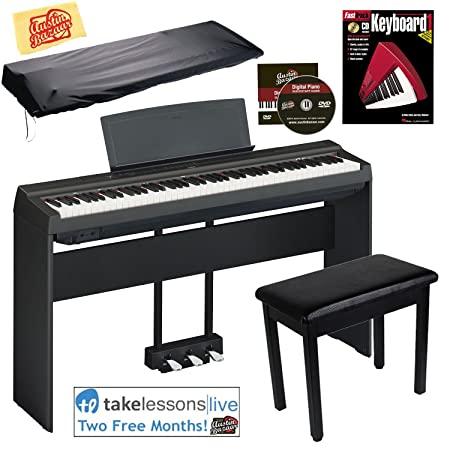
Digital Piano vs. Acoustic Piano
This section focuses on the differences between acoustic pianos and digital pianos, and why opt for the latter instruments instead of the former.
1. Maintenance
Acoustic pianos feature wooden exteriors, steel strings and felt hammers. The different components require proper care and maintenance due to their delicate nature.
Moreover, it has to be tuned once or twice a year, atop being vulnerable to fluctuations in temperature and humidity. This is attributed to acoustic piano’s sensitive felt and wood components.
Technicians can adjust tuning screws and sand wooden surfaces through the regulation process to restore a piano’s accuracy to optimal levels.
However, digital pianos require little to no maintenance.
2. Sound
Acoustic pianos produce better sound quality than digital pianos. With acoustic pianos, sound is produced when a built-in hammer hits a string. The acoustic sound produced is warmer and authentic with a resonant tone. The musician has more control over the musical notes’ expression and articulation.
On the other hand, as mentioned before, digital pianos mimic acoustic sounds. The sound produced is in the form of a digital file, hence doesn’t support acoustic nuances. However, a high-end model of a digital piano produces better sound than an acoustic piano model of lower quality.
3. Sensitivity to Touch
Acoustic pianos feature heavier and more sensitive keys, meaning more strength or effort goes into striking keys to produce sound. However, a gentle touch on the keys of a digital piano is enough to produce sound.
This means the acoustic and digital pianos differ in terms of feel and touch when playing. Therefore, some digital pianos feature weighted keys to mimic the functionality, weight and performance of keys on acoustic pianos.
Lack of sensitivity to touch in digital pianos have seen some pianists avoid them. With more touch-sensitivity, finger movement and strength influence sound tones. This means the same keys can produce various sound shades.
However, digital pianos produce limited tones of sound. It indicates that playing keys differently may not produce a different shade of sound. As a result, it can affect music expression.
4. Versatility
Although digital pianos don’t produce better sound than acoustic pianos, they’re built with additional features to make up for the lack in sound. As a result, digital pianos are more versatile in terms of portability and use.
Digital pianos produce unlimited sounds of other instruments such as a choir or saxophone to suit different needs. For instance, playing to the beats of a drum can transform an electronic keyboard into a small ensemble.
The pianos can also be connected to computers to record sounds in the form of digital files to allow for editing using software. They also feature headphone output and volume knobs to adjust sound to a desired level.
Although digital pianos vary in size and type, they’re more portable than acoustic pianos. Therefore, they can easily be moved by a single person, and support mobile use for live performances and gigs.
5. Pedals
Acoustic pianos come with sostenuto, soft and sustain pedals while digital pianos only feature sustain pedals (used in all kinds of music genres). However, portable digital pianos feature no pedals.
Sustain pedals can be bought separately as an add-on accessory if it can make a difference in the piano-playing experience.
6. Price
Acoustic pianos are more expensive than digital pianos, hence they have higher resale values. However, a piano’s resale value depends on its condition and model. With more digital pianos being released every year, the instruments depreciate faster than their acoustic counterparts.
7. Music Genre
Acoustic pianos have higher touch-sensitivity, making them ideal for classical music. This is attributed to the dynamics and more subtle expressions of music in the classical genre.
On the other hand, digital pianos are ideal for rock, pop or funk music. The playing experience is supplemented with the extra features such as drum beats and the sounds of other instruments in the electronic keyboards. It includes the digital nature of the sounds.
8. Location and Hours of Practice
Digital pianos are ideal for home or late night use in environments where family members are busy working. They feature headphone outputs and volume knobs to make practice sessions personal.
9. Proficiency Level
Digital pianos provide endless learning opportunities in the form of apps and learning software, making them ideal for beginners. Some models feature built-in learning applications. On the other hand, the cost of acoustic pianos, including complexity, make them ideal for players with advanced skill level.
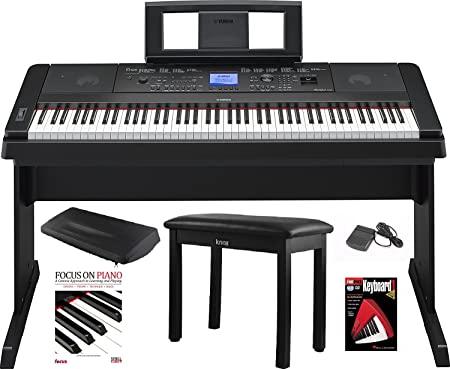
Types of Digital Pianos
Keyboards have changed over the years to integrate technology and more compact options. Digital pianos are built with a myriad effects, musical styles, features, sounds and possibilities for creation and editing.
They vary in physical appearance from designs that resemble real pianos (grands and uprights) to simple portable variations. The former type of digital pianos come with authentic graded or weighted keys for hammer action.
Available as “88 keys digital pianos” (stage and portable pianos), the pianos often come with features of acoustic pianos and electronic keyboards.
As mentioned, digital pianos can either resemble acoustic pianos in appearance or come in compact versions. The latter are often accompanied with stands that give the instrument a vertical design when assembled.
Moreover, keyboards come with 61 keys while a standard digital piano can feature as many as 88 keys. When categorized based on intended application, digital pianos are available as stage pianos and console pianos. The former find use at home while the latter type of pianos support portable stage performance for musicians.
The two categories of electronic keyboards differ in terms of exterior design and appearance, but deliver similar electronic sounds and “guts.” What makes console pianos ideal for the home setting are their conventional cabinet design.
Here’re a few types of digital pianos
1. Traditional Digital Pianos
Designed to resemble a spinet harpsichord or electronic organ, conventional digital pianos come with open bottoms. However, some designs or models are founded on a traditional upright piano’s casework, including pedals that resemble authentic piano pedals and a completely enclosed lower section.
More recently, conventional digital pianos come in unique and distinct physical designs not available in traditional pianos. For instance, brands such as Kawai, Yamaha and Casio, have models built to sit against walls. They have short heights and upright designs.
Unlike true traditional pianos, conventional digital pianos offer increased portability. This means they can be used in various places, including studios, homes, stages and venues for live performance.
2. Upright Digital Pianos
Categorized under conventional digital pianos, upright pianos come in classical designs. They resemble acoustic pianos in upright designs and size, but more lightweight.
Designed for home use, the pianos are more costly than other types of digital pianos. High-end models come with wooden keys instead of the standard plastic key-bed.
3. The Grand Digital Pianos
Designed to resemble a grand piano, this type of digital piano comes with a more accurate keyboard action. Together with a top quality sound system, the two are built into the instrument’s cabinet just as in a grand piano’s strings.
The high-end piano models are rare on the market and available under a few brands. Therefore, unlike standard acoustic pianos, grand digital pianos are more expensive.
4. Stage Pianos
Stage pianos are designed for professional use. They support professional audio, live performances and recording in studios. The digital pianos resemble generic music or synthesizer workstations, but not an acoustic piano’s appearance.
However, they’re not built with internal amplification or loudspeakers. Instead, they use powerful PA systems and keyboard amplifiers. But, some models come with powered built-in speakers.
5. Portable Digital Pianos
Portable digital pianos combine the features of a traditional digital keyboard with those of stage pianos. Designed for multi-purpose use, portable electronic keyboards find use in studios, homes, stages, and schools, including personal use.
Although it resembles a stage piano, the portable piano is more lightweight and comes in a compact design. They’re also designed with built-in loudspeakers and amplifiers at lower costs.
Built with a simple synthesis sound system, the sound quality of this digital piano is as good as that of a regular digital keyboard. However, some still use a sound engine similar to those found in advanced digital piano models.
Whereas some portable digital pianos fit into the stands of regular keyboards such as a stage piano, others come with matching stands to resemble console digital pianos upon assembly.
The weighted keys of a portable piano are less complex in design to reduce costs. Therefore, unlike most digital pianos, the feel of their keys is less authentic. Even so, the pianos also use emulated weight mechanism, with heavier keys being lighter than lower keys. The converse is also true.
However, the keys are less accurate than higher-end pianos. Some models also feature keys that resemble synthetic ivory instead of the regular plastic keys.
6. Hybrid Digital Pianos
These digital pianos integrate high-quality samples and authentic piano actions of acoustic pianos. They deliver high performance.
The hybrid piano is a combination of the acoustic and digital pianos. It offers the best of both pianos. Although it’s built with an acoustic piano’s action mechanism, the instrument can be activated digitally to produce sound.
Pianists can play warm acoustic sounds or switch to enjoy the extra features built onto the digital mode. The Kawai AnyTime Piano and the Yamaha NU1 Piano are good examples of hybrid pianos.
However, hybrid pianos are the most expensive and produce debatable quality of sound. But, that’s a decision for an individual to make.
7. Digital Piano Modules
These are sound modules designed to feature piano samples. However, they lack keyboards. A good example of this type of digital piano is the Roland MKS-20 Piano Module. The software synthesizer known as Pianotea has characteristics similar to a piano module.
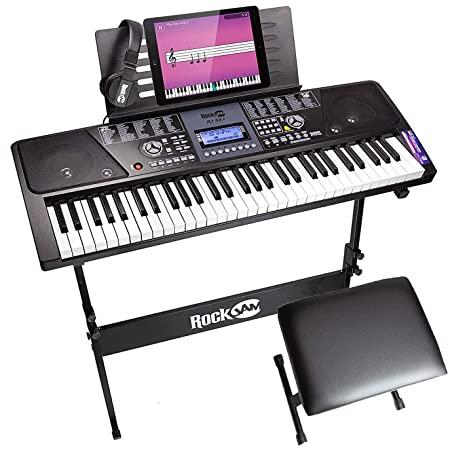
Specification of Digital Pianos
Digital pianos come with many features and specifications. The specs include, but are not limited to the following:
1. Digital Sampling
Digital pianos mimic acoustic piano sounds. They play back specific recorded “samples” from a pro studio’s built-in instrument. However, it takes lots of effort, memory and time, making the process difficult.
Therefore, an individual piano’s general sound quality and price depends on the digital sampling spec.
2. Weighted Action
Advanced keyboard models on electronic keyboards use “weighted” wooden keys with model hammers to mimic the hammer response when it hits the strings. This helps simulate the feel and touch of acoustic piano keys when playing a digital piano.
Graded hammers with progressively heavier feel in the bottom octaves are integrated into the most complex piano setups. As a result, the digital pianos deliver an authentic feel.
An electronic keyboard can either be semi-weighted or fully weighted. Whereas the former feels less realistic and is more cost-effective, the latter delivers the most realistic feel at a higher cost.
3. Velocity Sensitivity
This feature comprise of a keyboard to sense how hard a pianist strikes the keys and a sound engine with note recordings at each “striking intensity.”
They support the creation of realistic volume adjustments based on how hard fingers strike keys on the digital piano.
Cheap keyboards lack the two features, resulting in similar notes being played at the same volume level despite a pianist’s striking intensity.
Mid-range electronic keyboards with the capability to sense the intensity of striking keys, play similar notes or samples, but at different levels of volume.
On the other hand, the best digital pianos feature complex sound engines and the capability to sense striking intensity. The result is a variation in volume, strokes or “attack” and notes. The pianos deliver realism at optimal levels within playing dynamics.
4. Speakers and Outputs
Digital pianos can feature speakers or outputs based on their intended application. It’s rare to find both on a single instrument.
For instance, internal speakers are integrated in pianos designed for home use. On the other hand, pianos for recording purposes require analog and digital outputs on a single instrument.
Similarly, electronic keyboards with multiple analog outputs are found in pianos designed for live performances.
5. The Number of Keys
A full-size 88-keys piano is an ideal option for studio use or live performances. It can also make a perfect interior décor center-piece in living rooms.
However, a smaller instrument with 76 or 61 keys is ideal for beginner use at home or as a secondary music instrument in the home studio.
Mini electronic keyboards with 25 keys or 49 keys are also available on the market.
6. The Number of Tones/Sounds
Electronic keyboards feature all kinds of sounds such as melodic instruments with sounds from organs, accordions, flutes or synthesizers. Rhythmic sounds are obtained from hand percussion and drums. Effects include chorus, reverb and delay.
Despite the impressive nature of these sounds, most players use two to three sounds only, including some light reverb effects.
7. Polyphony
This is the number of voices available in any given instrument that can be played simultaneously. Many players are unaware of this feature that’s dependent on the sound engine.
They range from 32-note to 264-note polyphony on cheap and higher-end piano models, respectively. Yet, with just 10 fingers for playing, the available polyphony on any given instrument may seem excess.
However, higher polyphony comes in handy as accompaniments in cases where the backing tracks utilize dozens of voices from different instruments.
They’re also necessary for usage with sustain pedals; notes played ring for many seconds prior to going silent. Higher polyphony also supports the use of synthesizer or organ tones. This involves a single chord activating dozens of voices and a single key-stroke triggering several voices simultaneously.
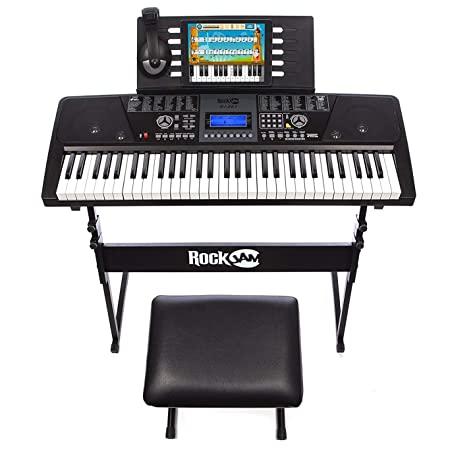
Digital Piano Accessories
Digital pianos also come with various accessories to increase their functionality. Although some pianos come with the accessories bundled in the package, you may need to buy them independently. Optional accessories include the following:
Amps and Cables
Console digital pianos for home use feature built-in amps and internal speakers. However, stage pianos feature analog and digital outputs for connections to external amplifiers and speakers.
They add extra volume in large venues. Most cables come with shorter or longer ¼” phone jack connectors and XLR cables. They support portable use of digital pianos.
Piano Benches
Console electronic keyboards can feature a matching bench. However, most pianos don’t come with the seating. In such a case, one can be bought separately. The benches can be cushioned for comfort, folded for portability and feature deadbolt joints for stability.
Piano benches vary in price, finishes, and come with fixed or adjustable height for home or portable use, respectively.
Gig Bags, Covers and Cases
Covers support storage of digital pianos at home. On the other hand, cases and gig bags are ideal for traveling artists moving with their pianos from place to place.
Covers stretch over the instruments to protect them from moisture, spills (accidental or not) and surface damages. However, gig bags make pianos easy to transport while protecting them.
Rigid in design, cases offer the highest level of protection for portable pianos. They can be washable, adjustable, padded and durable.
Stands for Digital Pianos
Stands are available in different sizes, styles and capabilities to hold digital pianos while in use. Whereas some stands are built to hold just one keyboard, others can support up to two electronic keyboards. S-style and table stands are the most common in the market.
Digital Piano Manufacturers
The number of digital piano manufacturers on the market is endless. A walk into a music store reveals the various popular and even unknown brands on the market. The top brands include Kawai, Yamaha, Korg, Roland, Casio and Williams.
1. Yamaha
Yamaha is a reputable manufacturer of musical instruments. With decades of experience in the industry, the brand is well-known and highly-regarded among musicians and artists across the world.
The company manufactures all kinds of digital pianos ranging from simple keyboards for beginner pianists to professional digital grand pianos, and anything in between.
The best Yamaha digital pianos are versatile and reliable. They showcase unmatched craftsmanship and high sound quality.
2. Kawai
Kawai has been manufacturing acoustic pianos for more than a century. Popular for their high quality sounds and authentic feel, Kawai digital pianos have been offering unmatched experiences for decades.
Available in beautiful designs and high quality craftsmanship, the various pianos from this brand enjoy extensive use worldwide. Over the years, they’ve also won several awards for top performance and enjoy thousands of positive reviews online.
Maintenance and Cleaning of Digital Pianos
Digital pianos, just like any other instrument or gadget, require proper care and maintenance to last long. Acoustic pianos require intensive maintenance, but their digital counterparts are said to need less care. However, they need some care as electronic devices to prolong their lifespan.
Electronic keyboards feature adjustable and automated features. After spending a lot of money and time on a digital piano, it’s only prudent that they’re cared for and maintained to keep them in good working conditions.
Here’re are tips to keep digital pianos in top condition:
1. Place them in Perfect Locations
A digital piano deserves the kind of treatment accorded to traditional acoustic pianos. Water, heat and humidity can easily damage any kind of piano. This explains the need to choose a good location indoors to place the piano.
The best location for a piano is free from the following:
- Direct exposure to water, sunlight and moisture
- High foot traffic
- Electronic appliances such as computers, heaters and stoves, because they emit heat
- Placement less than 4 meters away from sources of heat
2. Clean with Appropriate Methods
No digital piano is immune to damages, including cleaning using inappropriate methods. Here’re tips to cleaning electronic keyboards:
- Use a clean, soft, dry cloth for cleaning surfaces; avoid wet cloth or using water.
- Check user manuals for recommended cleaning methods to be safe.
- Wash your hands and dry them before touching the piano. This keeps dirt and grease from the keys. They can also hamper how fingers interact with the keys during use.
3. Plug in the Piano properly
Improper plugging and faulty power outlets can damage pianos and even cause accidents. Consider the following tips:
- Don’t share a single outlet with other electronics such as computers to maintain the general performance and sound quality of a piano. Overloading outlets can also cause injuries, damages to the keyboard, or even short-circuiting.
- Organize cables and cords for storage to avoid accidental tripping.
- Use outlets in good working condition and assess the outlet strips and surge suppressors for replacement.
- Unplug pianos when not in use; put off the switch prior to unplugging the instrument.
4. Use the Piano as the Manufacturer Intended
A digital piano is designed for playing, but not anything else. Avoid using your piano for any of the following:
- A dining table for eating; foods and drinks can easily spill on the piano and cause damage.
- A shelf; excess weight can mar the surface, damage the frame or even impair sound.
- Drinking any liquids to avoid accidental spills on the instrument’s sensitive keys.
- Leaning on the piano can result in the instrument falling, tilting, or getting damaged.
5. Offer Protection
Protect the piano while in storage. Do the following:
- Cover the keys for protection from dirt and dust.
- Keep pets away from the instrument because fur, hair, scratches and claw marks can damage sensitive parts and surfaces of the piano.
- Turn off the instrument after use; follow the manufacturer’s recommended procedure for doing so.
In case the piano is damaged or faulty, find a reliable and trustworthy technician with relevant experience to fix the issues. Check the instrument’s warranty to find out if your piano is still covered.
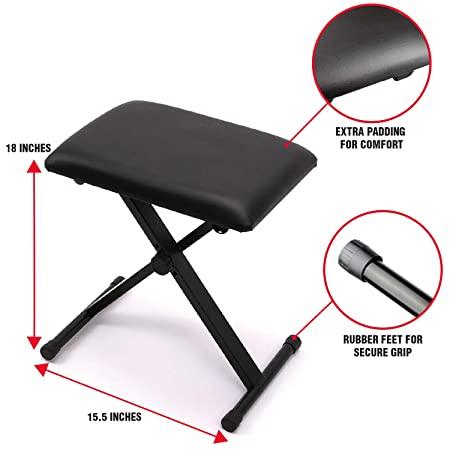
Conclusion
Digital pianos, unlike acoustic pianos, have so much in store for the pianist. Ranging from reduced costs to added features and increased portability, there’re many reasons to opt for an electronic keyboard.
Check out our buying guide below to find out what it takes to choose and buy the best digital piano on the market.
Resources:
Libertyparkmusic
Ehomerecordingstudio
